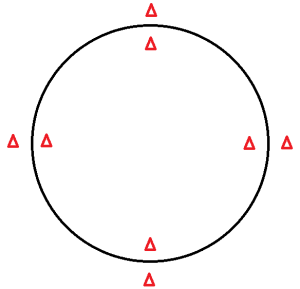Last weekend I attended the Midwest Horse Fair in Wisconsin. It is my favorite version of continued education! I saw a seminar by Jonathan Field using a circle pattern I thought would be good the share with you all. Enjoy!
Circle Exercises for Steering, Rating Speed, Bending and Canter Departs
From the seminars on “Active Neutral” by Jonathan Field at the Midwest Horse Fair 2015 Madison Wisconsin. Adapted by myself for therapeutic riding lessons.
Arena setup:
- 8 cones
- Set up the cones in pairs on the 4 quarters of a 20 meter circle:
Prerequisites: the rider should know…
- Basic steering aids (seat, legs, hands)
- Basic aids to rate their horse’s speed (seat, legs, hands)
- Basic concept of bending
Purpose of the exercise:
- For the rider: learns to maintain the horse’s bend and speed on a circle using the leg, seat and rein aids.
- For the horse: teaches him to maintain path, speed, bend and balance on a circle so that you can set him and leave him, leaving the rider free to use the aids for other things. Also results in the horse finding comfort in movement, therefore relaxing, and having a familiar pattern to return to when he is anxious.
The exercise:
Do the following at both the walk and trot.
- Set the Path & Speed
- Start the horse on the circle.
- Use your seat and leg aids to intentionally direct the horse and keep him there.
- When the horse is on the correct path and speed, leave him alone.
- When he deviates, correct with the seat and leg (move him over to the outside), then the reins (if needed), and when he gets back on track leave him alone (don’t get “inside-rein-itis”).
- Count how far the horse will keep going before you have to correct him. It should start getting longer between corrections, until you don’t have to correct him at all.
- Once this has been accomplished, move on to…
- Set the Bend & Balance
- When the rider enters the cones, they will ask their horse to step over or leg yield 1 step to the outside.
- This helps the horse bend to the inside and shift his balance to the outside, so he’s not falling on his inside shoulder.
- When the horse responds, release.
- When the horse is bending and balancing well, leave him alone.
- Start with asking for the bend at the same 1 pair of cones on the circle every lap, or every other pair of cones such as just the 2 pairs on the centerline. They can progress to asking for the bend at all 4 pairs, but this might be too much for the rider and/or horse, so use your best judgement.
- Relax
- As both the horse and rider learn the drill, they can relax and find comfort in it.
- The horse learns that when he’s in the correct way of going, there is comfort. He also has a relaxing exercise he knows and can go back to when he gets anxious or spooky. If the horse blows and relaxes, point out to the rider how the exercise is working.
- Repeat the other direction.
Circle Exercise for Canter Departs
Use the same arena setup above for the following exercise to help with canter departs.
- Prepare
- Point out how the circle is split into 4 quarters.
- Each quarter you’ll practice something different, but all relate to the canter.
- Walk for ¼ of the circle
- Establish a consistent path, speed, bend, and balance as in the above exercise.
- Trot for ¼ of the circle
- Pick up the trot exactly between the cones, to get the horse listening.
- Set up the canter departure for ¼ of the circle.
- Set the horse’s shoulders off to the outside to clear room for the inside hind to make a good strike off. As opposed to if the inside fore is in front of the inside hind, he’ll fall into the canter.
- Strike off and canter ¼ of the circle.
- Strike off exactly between the cones.
- Aids: Inside rein and leg open. Outside rein cues.
- Canter 1 lap.
- Bring back down to walk. Repeat.
Have you used this pattern before? In what other ways?
****************
Note: This is not professional advice, this is a blog. I am not liable for what you do with or how you use this information. The activities explained in this blog may not be fit for every rider, riding instructor, or riding center depending on their current condition and resources. Use your best personal judgment!
